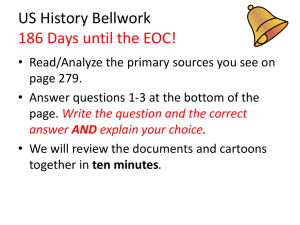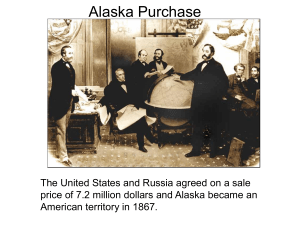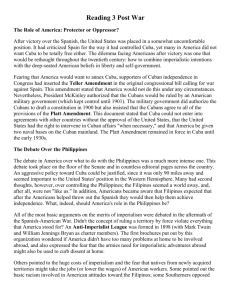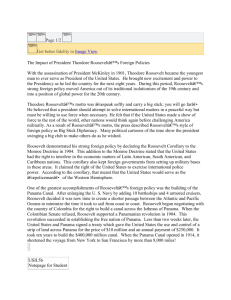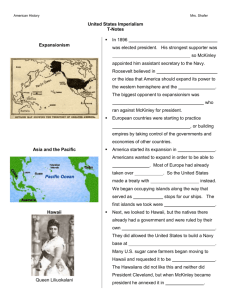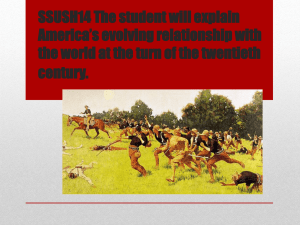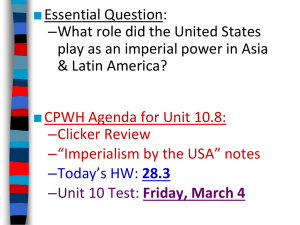America Becomes a World Power
advertisement
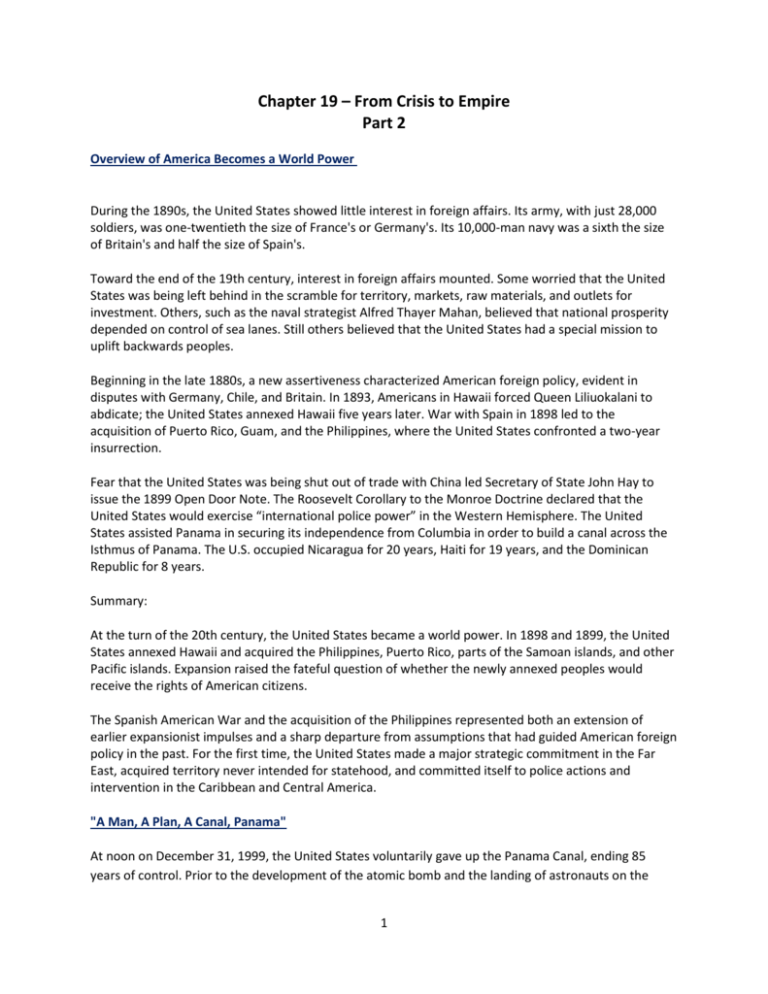
Chapter 19 – From Crisis to Empire Part 2 Overview of America Becomes a World Power During the 1890s, the United States showed little interest in foreign affairs. Its army, with just 28,000 soldiers, was one-twentieth the size of France's or Germany's. Its 10,000-man navy was a sixth the size of Britain's and half the size of Spain's. Toward the end of the 19th century, interest in foreign affairs mounted. Some worried that the United States was being left behind in the scramble for territory, markets, raw materials, and outlets for investment. Others, such as the naval strategist Alfred Thayer Mahan, believed that national prosperity depended on control of sea lanes. Still others believed that the United States had a special mission to uplift backwards peoples. Beginning in the late 1880s, a new assertiveness characterized American foreign policy, evident in disputes with Germany, Chile, and Britain. In 1893, Americans in Hawaii forced Queen Liliuokalani to abdicate; the United States annexed Hawaii five years later. War with Spain in 1898 led to the acquisition of Puerto Rico, Guam, and the Philippines, where the United States confronted a two-year insurrection. Fear that the United States was being shut out of trade with China led Secretary of State John Hay to issue the 1899 Open Door Note. The Roosevelt Corollary to the Monroe Doctrine declared that the United States would exercise “international police power” in the Western Hemisphere. The United States assisted Panama in securing its independence from Columbia in order to build a canal across the Isthmus of Panama. The U.S. occupied Nicaragua for 20 years, Haiti for 19 years, and the Dominican Republic for 8 years. Summary: At the turn of the 20th century, the United States became a world power. In 1898 and 1899, the United States annexed Hawaii and acquired the Philippines, Puerto Rico, parts of the Samoan islands, and other Pacific islands. Expansion raised the fateful question of whether the newly annexed peoples would receive the rights of American citizens. The Spanish American War and the acquisition of the Philippines represented both an extension of earlier expansionist impulses and a sharp departure from assumptions that had guided American foreign policy in the past. For the first time, the United States made a major strategic commitment in the Far East, acquired territory never intended for statehood, and committed itself to police actions and intervention in the Caribbean and Central America. "A Man, A Plan, A Canal, Panama" At noon on December 31, 1999, the United States voluntarily gave up the Panama Canal, ending 85 years of control. Prior to the development of the atomic bomb and the landing of astronauts on the 1 moon, the Panama Canal was perhaps this country's signal engineering achievement. Fifty-one miles long, with about $3.5 billion in bases and infrastructure, the canal links the Atlantic and Pacific oceans. At the end of the 20th century, the canal was no longer essential to U.S. strategic or economic interests. Aircraft carriers and oil tankers were too large to pass through the canal's locks. Earlier in the century, however, the canal was regarded as a vital national interest. During World War II, the United States stationed 65,000 troops in Panama to protect the canal. A number of U.S. interventions in the Caribbean and Central America were undertaken largely to protect the canal from hostile powers. The canal's construction was a phenomenal undertaking. In 1850, U.S. interests in Panama built a railroad across the Isthmus to transport '49ers to California. In 1879, the French, fresh from their success in building the Suez Canal, started building the canal. Over the next 20 years, between 16,000 and 22,000 workers died from malaria, yellow fever, typhoid, snake bites, and accidents. Torrential rains averaging 200 inches a year washed away much of the work. America's 1898 war with Spain made a canal seem essential. During the Spanish American War, the only way for U.S. battleships to sail from the Atlantic to the Pacific Ocean was to make an 8,000 mile journey around Cape Horn at the tip of South America. The canal was completed in the face of seemingly insurmountable political, medical, and technological obstacles. The Isthmus of Panama was located in Colombia, which had rejected a U.S. proposal to build a canal. "You could no more make an agreement with them than you could nail currant jelly to a wall," President Theodore Roosevelt said in response to the rejection. A French adventurer, Philippe Bunau-Varilla, and an American lawyer, Nelson Cromwell, conceived of the idea of creating the Republic of Panama. They persuaded Roosevelt to support a Panama. BunauVarilla engineered a revolution and U.S. warships prevented Colombia from stopping Panama's attempt to break away (In 1921, the U.S. paid an indemnity to Colombia in recognition of the U.S. role in the Panamanian revolution). Bunau-Varilla repaid the United States for its assistance by signing a treaty on behalf of the Panamanians, which gave the United States a zone stretching five miles from each bank of the canal in perpetuity. Within the zone, U.S. laws, police, and courts ruled. Years later, President Roosevelt said that the people of Panama rebelled against Colombia "literally as one man." A senator quipped, "Yes, and the one man was Roosevelt." In 1911, Roosevelt said bluntly, "I took the Isthmus, started the canal and then left Congress not to debate the canal but to debate me." In 1906, eager to see the greatest accomplishment of his presidency, he became the first president to travel overseas. He went to Panama at the height of the rainy season and took the controls of a 95-ton steam shovel. During the construction of the canal, William Gorgas, an army physician, tried to reduce the number of deaths caused by disease. He oversaw the massive draining of swamps in order to eliminate mosquitoes that carried yellow fever and malaria. The French had attempted to build a canal at sea level, but grossly underestimated the difficulty of achieving this goal. To allow ships to travel between the oceans, American engineers designed a system of locks capable of raising and lowering ships 64 feet by using the force of gravity and 40-horsepower 2 motors to move the gates. One set of locks used enough concrete to build a wall 8-feet thick and 12-feet high, stretching between Cleveland and Pittsburgh. At its peak in 1913, the workforce consisted of 44,000 persons. West Indian workers were the canal's unsung heroes. Each day, 200 trainloads of dirt had to be hauled away. More than 25,000 worked as canal diggers--three times the number of Americans who worked on the canal. Between 1904 and 1915, some 5,600 lives were lost to disease and accidents. Most of those who died were from Barbados. The quinine used to treat malaria left many workers deaf. In December 1908, a massive 22 tons of dynamite exploded prematurely, killing 23 workers. Built at a cost of $387 million over a period of 10 years, the Panama Canal was a declaration of America's coming of age in the world. The United States Becomes a World Power By 1890, the United States had by far the world's most productive economy. American industry produced twice as much as its closest competitor--Britain. But the United States was not a great military or diplomatic power. Its army numbered less than 30,000 troops, and its navy had only about 10,000 seamen. Britain's army was five times the size of its American counterpart, and its navy was ten times bigger. The United States' military was small because the country was situated between two large oceans and was surrounded by weak or friendly nations. It faced no serious military threats and had little interest in asserting military power overseas. From the Civil War until the 1890s, most Americans had little interest in territorial expansion. William Seward, the secretary of state under presidents Lincoln and Johnson, did envision American expansion into Alaska, Canada, Mexico, Central America, the Caribbean, Iceland, Greenland, Hawaii, and other Pacific islands. But he realized only two small parts of this vision. In 1867, the United States purchased Alaska from Russia for $72 million and occupied the Midway Islands in the Pacific. Americans resisted expansion for two major reasons. One was that imperial rule seemed inconsistent with America's republican principles. The other was that the United States was uninterested in acquiring people with different cultures, languages, and religions. But where an older generation of moralists thought that ruling a people without their consent violated a core principle of republicanism, a younger generation believed that the United States had a duty to uplift backward societies. By the mid-1890s, a shift had taken place in American attitudes toward expansion that was sparked partly by a European scramble for empire. Between 1870 and 1900, the European powers seized 10 million square miles of territory in Africa and Asia, a fifth of the world's land mass. About 150 million people were subjected to colonial rule. In the United States, a growing number of policy makers, bankers, manufacturers, and trade unions grew fearful that the country might be closed out in the struggle for global markets and raw materials. A belief that the world's nations were engaged in a Darwinian struggle for survival and that countries that failed to compete were doomed to decline also contributed to a new assertiveness on the part of the United States. By the 1890s, the American economy was increasingly dependent on foreign trade. A quarter of the nation's farm products and half its petroleum were sold overseas. 3 Alfred Thayer Mahan, a naval strategist and the author of The Influence of Sea Power Upon History, argued that national prosperity and power depended on control of the world's sea-lanes. "Whoever rules the waves rules the world," Mahan wrote. To become a major naval power, the United States began to replace its wooden sailing ships with steel vessels powered by coal or oil in 1883. But control of the seas would also require the acquisition of naval bases and coaling stations. Germany's Kaiser Wilhelm had copies of Mahan's books placed on every ship in the German High Seas Fleet and the Japanese government put translations in its imperial bureaus. During the late 19th century, the idea that the United States had a special mission to uplift "backward" people around the world also commanded growing support. The mainstream Protestant religious denominations established religion missions in Africa and Asia, including 500 missions in China by 1890. During the late 1880s, American foreign policy makers began to display a new assertiveness. The United States came close to declaring war against Germany over Samoa in 1889; against Chile in 1891, over the treatment of U.S. sailors; and against Britain in 1895, over a territorial dispute between Venezuela and Britain. American involvement in the overthrow of Hawaii's monarchy in 1893 precipitated a momentous debate over the United States' global role. They debated whether the U.S. should behave like a great power and seize colonies or whether it should remain something different. The Annexation of Hawaii After a century of American rule, many native Hawaiians remain bitter about how the United States acquired the islands, located 2,500 miles from the West Coast. In 1893, a small group of sugar and pineapple-growing businessmen, aided by the American minister to Hawaii and backed by heavily armed U.S. soldiers and marines, deposed Hawaii's queen. Subsequently, they imprisoned the queen and seized 1.75 million acres of crown land and conspired to annex the islands to the United States. On January 17, 1893, the conspirators announced the overthrow of the queen's government. To avoid bloodshed, Queen Lydia Kamakaeha Liliuokalani yielded her sovereignty and called upon the U.S. government "to undo the actions of its representatives." The U.S. government refused to help her regain her throne. When she died in 1917, Hawaii was an American territory. In 1959, Hawaii became the 50th state after a plebiscite in which 90 percent of the islanders supported statehood. The businessmen who conspired to overthrow the queen claimed that they were overthrowing a corrupt, dissolute regime in order of advance democratic principles. They also argued that a Western power was likely to acquire the islands. Hawaii had the finest harbor in the mid-Pacific and was viewed as a strategically valuable coaling station and naval base. In 1851, King Kamehameha III had secretly asked the United States to annex Hawaii, but Secretary of State Daniel Webster declined, saying "No power ought to take possession of the islands as a conquest...or colonization." But later monarchs wanted to maintain Hawaii's independence. The native population proved to be vulnerable to western diseases, including cholera, smallpox, and leprosy. By 1891, native Hawaii's were an ethnic minority on the islands. 4 After the bloodless 1893 revolution, the American businessmen lobbied President Benjamin Harrison and Congress to annex the Hawaiian Islands. In his last month in office, Harrison sent an annexation treaty to the Senate for confirmation, but the new president, Grover Cleveland, withdrew the treaty "for the purpose of re-examination." He also received Queen Liliuokalani and replaced the American stars and stripes in Honolulu with the Hawaiian flag. Cleveland also ordered a study of the Hawaiian revolution. The inquiry concluded that the American minister to Hawaii had conspired with the businessmen to overthrow the queen, and that the coup would have failed "but for the landing of the United States forces upon false pretexts respecting the dangers to life and property." Looking back on the Hawaii takeover, President Cleveland later wrote that "the provisional government owes its existence to an armed invasion by the United States. By an act of war...a substantial wrong has been done." President Cleveland's recommendation that the monarchy be restored was rejected by Congress. The House of Representatives voted to censure the U.S. minister to Hawaii and adopted a resolution opposing annexation. But Congress did not act to restore the monarchy. In 1894, Sanford Dole, who was beginning his pineapple business, declared himself president of the Republic of Hawaii without a popular vote. The new government found the queen guilty of treason and sentenced her to five years of hard labor and a $5,000 fine. While the sentence of hard labor was not carried out, the queen was placed under house arrest. The Republican Party platform in the presidential election of 1896 called for the annexation of Hawaii. Petitions for a popular vote in Hawaii were ignored. Fearing that he lacked two-thirds support for annexation in the Senate, the new Republican president, William McKinley, called for a joint resolution of Congress (the same way that the United States had acquired Texas). With the country aroused by the Spanish American War and political leaders fearful that the islands might be annexed by Japan, the joint resolution easily passed Congress. Hawaii officially became a U.S. territory in 1900. When Capt. James Cooke, the British explorer, arrived in Hawaii in 1778, there were about 300,000 Hawaiians on the islands; however, infectious diseases reduced the native population. Today, about 20 percent of Hawaii's people are of native Hawaiian ancestry, and only about 10,000 are of pure Hawaiian descent. Native Hawaiians were poorer, less healthy, and less educated than members of other major ethnic groups on the islands. Sugar growers, who dominated the islands' economy, imported thousands of immigrant laborers first from China, then Japan, then Portuguese from Madeira and the Azores, followed by Puerto Ricans, Koreans, and most recently Filipinos. As a result, Hawaii has one of the world's most multicultural populations. In 1993, a joined Congressional resolution, signed by President Bill Clinton, apologized for the U.S. role in the overthrow. The House approved the resolution by voice vote. The Senate passed it 65 to 34 votes. 5 The Spanish American War, 1898 The debate over America's global role intensified when Cubans began to fight for their independence from Spain in 1895. Americans were sympathetic to Cuba's struggle for independence, but were divided about how to help. The Republican speaker of the House did not want "to spill American blood," unless American interests were directly threatened, whereas Theodore Roosevelt, the Republican assistant secretary of the Navy, pushed for war against Spain. President William McKinley was deeply ambivalent about war against Spain. The last president to have served in the Civil War, McKinley said he had seen too much carnage at battles like Antietam to be enthusiastic about war with Spain. "I've been through one war. I have seen the dead piled up, and I do not want to see another." Ultimately, however, the pressure of public opinion forced McKinley into the war that made the United States an international power. Newspaper publishers like William Randolph Hearst and Joseph Pulitzer worked up war fever among the public with reports of Spanish atrocities against Cuban rebels. Then, Hearst's New York Journal published a leaked letter in which the chief Spanish diplomat in Washington, Enrique Duby de Lome, described President McKinley as "weak" and a "petty politician." Hearst publicized the DeLome letter under the screaming headline: "WORST INSULT TO THE UNITED STATES IN ITS HISTORY." Days later an explosion sank the U.S.S. Maine in Cuban's Havana harbor. A naval court of inquiry blamed the explosion on a mine, further inflaming public sentiment against Spain. Then a respected U.S. Senator, Redfield Proctor, after returning from a visit to Cuba, announced that he had reversed his position from isolationism to intervention "because of the spectacle of a million and a half people, the entire native population of Cuba, struggling for freedom and deliverance." After ten days of debate, Congress declared war, but only after adopting the Teller Amendment. The amendment made it clear that the United States did not harbor imperialist ambitions, and it announced that the United States would not acquire Cuba. European leaders were shocked by this declaration. Britain's Queen Victoria called on the European power to "unite...against such unheard [of] conduct," since the United States might in the future declare Ireland and other colonies independent. But after the United States defeated Spain, it set up a military government on Cuba and made the soldiers' withdrawal contingent on the Cubans accepting the Platt Amendment. The amendment gave the United States the right to intervene in Cuba to protect "life, property, and individual liberties." The 144-day war also resulted in the United States taking control of the Philippines, Puerto Rico, and Guam. The Philippines The 20th century began with the United States engaged in a bloody, but largely forgotten, war in the Philippines that cost hundreds of thousands of lives. The Philippine American War, fought from February 1899 to July 1902, claimed 250,000 lives and helped establish the United States as a power in the Pacific. 6 Today, few Americans are aware of the Philippine American War. The conflict was a sequel to the Spanish American War of 1898, which had been waged, in part, in support of Cubans fighting for independence from Spain. But it was also fueled by American desire to become a world power. The Philippine American War prompted Mark Twain and other writers and artists to speak out against those who advocated American expansion. It fueled a bitter national debate over U.S. involvement overseas, a precursor to the outcry over the Vietnam War a half-century later. Some who opposed the occupation were motivated by racism, fearful that annexation of the Philippines would lead to an influx of non-white immigrants. One U.S. senator warned of the coming of "tens of millions of Malays and other unspeakable Asiatics." Many, who considered the occupation immoral and inconsistent with American traditions and values, joined the Anti-Imperialist League. The conflict helped popularize the concept of the "white man's burden," the notion that the United States and Western European societies had a duty to civilize and uplift the "benighted" races of the world. A U.S. senator from Indiana declared: "We must never forget that in dealing with the Filipinos, we deal with children." The Philippine American War also paved the way for migration from the Philippines. Shortly after the war, Filipino immigrants began arriving in the United States as students, U.S. military personnel, or farm and cannery workers. Today, there are more than two million Filipinos and Filipino Americans in the United States, making them one of the nation's largest Asian communities. On May 1, 1898, Commodore George Dewey had entered Manila Bay and destroyed the decrepit Spanish fleet. In December, Spain ceded the Philippines to the Untied States for $20 million. Mark Twain called the $20 million payment an "entrance fee into society--the Society of Scepter Thieves." "We do not intend to free but to subjugate the people of the Philippines," he wrote. "We have pacified some thousands of the islanders and buried them, destroyed their fields, burned their villages, and turned their widows and orphans out of doors." On June 12, 1898, a young Filipino, General Emilio Aguinaldo, had proclaimed Philippine independence and established Asia's first republic. He had hoped that the Philippines would become a U.S. protectorate. But pressure on President William McKinley to annex the Philippines was intense. After originally declaring that it would "be criminal aggression" for the United States to annex the archipelago, he reversed his stance, partly out of fear that another power would seize the Philippines. Six weeks after Dewey defeated the Spanish fleet at Manila Bay, a German fleet sought to set up a naval base there. The British, French, and Japanese also sought bases in the Philippines. Unaware that the Philippines were the only predominantly Catholic nation in Asia, President McKinley said that American occupation was necessary to "uplift and Christianize" the Filipinos. On February 4, 1899, fighting erupted between American and Filipino soldiers, leaving 59 Americans and approximately 3,000 Filipinos dead. With the vice president casting a tie-breaking vote, a congressional resolution declaring the Philippines independent was defeated. American commanders hoped for a short conflict, but in the end, more than 70,000 would fight in the archipelago. Unable to defeat the United States in conventional warfare, the Filipinos adopted guerrilla tactics. To suppress the insurgency, villages were forcibly relocated or burned. Non-combatant civilians were imprisoned or killed. Vicious torture techniques were used on suspected insurrects, such as the water cure, in which a suspect was made to lie face up while water was poured onto his face. One general declared: 7 It may be necessary to kill half of the Filipinos in order that the remaining half of the population may be advanced to a higher plane of life than their present semi-barbarous state affords. The most notorious incident of the war took place on Samar Island. In retaliation for a Filipino raid on an American garrison, in which American troops had been massacred, General Jacob W. Smith told his men to turn the island into a "howling wilderness" so that "even birds could not live there." He directed a marine major to kill "all persons...capable of bearing arms." He meant everyone over the age of 10. Smith was court-martialed and "admonished" for violating military discipline. Aguinaldo was captured by a raid on the Filipino leader's hideout in March 1901. The war was officially declared over in July 1902, but fighting continued for several years. The Philippine war convinced the United States not to seize further overseas territory. More than 4,000 American soldiers and about 20,000 Filipino fighters died. An estimated 200,000 Filipino civilians died during the war, mainly of disease or hunger. Reports of American atrocities led the United States to turn internal control over to the Philippines to Filipinos in 1907 and pledged to grant the archipelago independence in 1916. U.S. leaders tried to transform the country into a showcase of American-style democracy in Asia. But there was a strong undercurrent of condescension. U.S. President William Howard Taft, who had served as governor-general of the Philippines, called the Filipinos "our little brown brothers." The Philippines were granted independence in 1946. Policing the Caribbean and Central America In 1904, Germany demanded a port in Santo Domingo (now the Dominican Republic) as compensation for an unpaid loan. Theodore Roosevelt, who had become president after William McKinley's assassination, told Germany to stay out of the Western Hemisphere and said that the United States would take care of the problem. He announced the Roosevelt Corollary to the Monroe Doctrine: Chronic wrongdoing, or an impotence which results in a general loosening of ties of civilized society, may in America, as elsewhere, ultimately require intervention by some civilized nation, and in the western hemisphere, the adherence of the U.S. to the Monroe Doctrine may force the United States, however reluctantly, in flagrant cases of wrongdoing or impotence, to the exercise of international police power. Several recent developments led Roosevelt to declare that the United States would be the policeman of the Caribbean and Central America. Three European nations had blockaded Venezuela's ports, violating the Monroe Doctrine's unilateral declaration that Europe should not interfere in the Americas. Meanwhile, an international court in The Hague in the Netherlands had ruled that a creditor nation that had used force would receive preference in repayment of a loan. Further, Roosevelt had recently gained the right to build the Panama Canal; he believed that any threat to the canal threatened U.S. strategic and economic interests. To enforce order, forestall foreign intervention, and protect U.S. economic interests, the United States intervened in the Caribbean and Central America some 20 times over the next quarter century--namely, in Cuba, the Dominican Republic, Haiti, Mexico, Nicaragua, and Panama. Each intervention followed a 8 common pattern: after intervening to restore order, U.S. forces became embroiled in the countries' internal political disputes. Before exiting, the United States would train and fund a police force and military to maintain order and would sponsor an election intended to put into power a strong leader supportive of American interests. Unfortunately, the men who took power in many of these countries, such as Anastasio Somoza in Nicaragua, Rafael Trujillo in the Dominican Republic, and Francois Duvalier in Haiti, established despotic rule. Intervention in Haiti In July 1915, a mob murdered Haiti's seventh president in seven years. Vilbrun Guillaume Sam was dragged out of the French legation and hacked to death. The mob then paraded his mutilated body through the streets of the Haitian capital of Port-au-Prince. During the preceding 72 years, Haiti had experience 102 revolts, wars, or coups; only one of the country's 22 presidents had served a complete term, and merely four died of natural causes. With the European powers engaged in World War I, President Woodrow Wilson feared that Germany might occupy Haiti and threaten the sea route to the Panama Canal. To protect U.S. interests and to restore order, the president sent 330 marines and sailors to Haiti. This was not the first time that Wilson had sent marines into Latin America. Determined to "teach Latin Americans to elect good men," he had sent American naval forces into Mexico in 1913 during the Mexican Revolution. American Marines seized the city of Veracruz and imposed martial law. The last marines did not leave Haiti until 1934. To ensure repayment of Haiti's debts, the United States took over the collection of customs duties. Americans also arbitrated disputes, distributed food and medicine, censored the press, and ran military courts. In addition, the United States helped build about a thousand miles of unpaved roads and a number of agricultural and vocational schools, and trained the Haitian army and police. It also helped to replace a government led by blacks with a government headed by mulattoes. The U.S. forced the Haitians to adopt a new constitution which gave American businessmen the right to own land in Haiti. While campaigning for vice president in 1920, Franklin D. Roosevelt, who had served as assistant secretary of the Navy in the Wilson Administration, later boasted, "I wrote Haiti's Constitution myself, and if I do say it, it was a pretty good little Constitution." Many Haitians resisted the American occupation. In the fall of 1918, Charlemagne Peralte, a former Haitian army officer, launched a guerrilla war against the U.S. Marines to protest a system of forced labor imposed by the United States to build roads in Haiti. In 1919, he was captured and killed by U.S. Marines, and his body was photographed against a door with a crucifix and a Haitian flag as a lesson to others. During the first five years of the occupation, American forces killed about 2,250 Haitians. In December 1929, U.S. Marines fired on a crowd of protesters armed with rocks and machetes, killing 12 and wounding 23. The incident stirred international condemnation and ultimately led to the end of the American occupation. By that time, Roosevelt had changed his mind. In 1928, he had criticized the Republican administrations for relying on the Marines and "gunboat diplomacy." "Single-handed intervention by us in the internal affairs of other nations in this hemisphere must end," he wrote. After he became president in 1933, Roosevelt proclaimed a new policy toward Latin America. Under the Good Neighbor policy, he removed American Marines from Haiti, the Dominican Republic, and Nicaragua. 9
